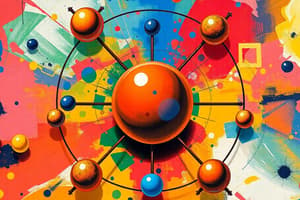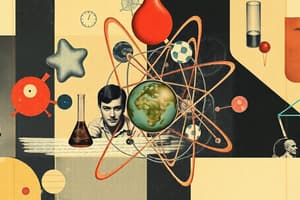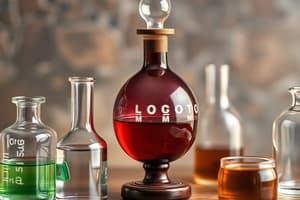Podcast
Questions and Answers
How did Rutherford's gold foil experiment refine Thomson's plum pudding model of the atom?
How did Rutherford's gold foil experiment refine Thomson's plum pudding model of the atom?
- It demonstrated that electrons are arranged in specific orbits around the nucleus.
- It suggested that the positive charge of an atom is concentrated in a small, central nucleus, contrary to Thomson's model. (correct)
- It proved that atoms are indivisible and indestructible, supporting Dalton's atomic theory.
- It confirmed the uniform distribution of positive charge throughout the atom, as Thomson proposed.
Which statement contrasts the atomic models of Bohr and Schrödinger?
Which statement contrasts the atomic models of Bohr and Schrödinger?
- Schrödinger's model incorporated neutrons, while Bohr's model only accounted for protons and electrons.
- Both Bohr and Schrödinger agreed that electrons are randomly scattered throughout the atom.
- Bohr proposed that electrons exist in fixed orbits, while Schrödinger described electrons existing in probability 'clouds'. (correct)
- Bohr's model included a positive nucleus, whereas Schrödinger's model described a neutral nucleus.
Consider an element with an atomic mass significantly higher than expected based solely on its number of protons. Which subatomic particle's discovery explains this discrepancy?
Consider an element with an atomic mass significantly higher than expected based solely on its number of protons. Which subatomic particle's discovery explains this discrepancy?
- Electron, which contributes to the overall negative charge.
- Proton, which determines the element's atomic number.
- Positron, which neutralizes the charge of electrons in the nucleus.
- Neutron, which adds mass without contributing to the charge. (correct)
How did the experiments using Cathode Ray Tubes (CRT) contribute to the development of atomic theory?
How did the experiments using Cathode Ray Tubes (CRT) contribute to the development of atomic theory?
Democritus proposed the concept of atoms in ancient times, yet his theory was not immediately accepted. What key limitation hindered its widespread acceptance?
Democritus proposed the concept of atoms in ancient times, yet his theory was not immediately accepted. What key limitation hindered its widespread acceptance?
Flashcards
Democritus
Democritus
Proposed atoms are indestructible and invisible, rejected by Aristotle.
John Dalton
John Dalton
Observed atoms are tiny, solid spheres that combine differently to form elements.
Eugene Goldstein
Eugene Goldstein
Discovered protons; found positive charge using Cathode Ray Tube.
Ernest Rutherford
Ernest Rutherford
Signup and view all the flashcards
Niels Bohr
Niels Bohr
Signup and view all the flashcards
Study Notes
Early Atomic Concepts
- Democritus (400 BC) proposed that atoms are indestructible and invisible.
- His theory was rejected by Aristotle.
19th Century Discoveries
- John Dalton (1808) theorized that elements are composed of tiny particles called atoms, considered spherical and solid.
- He suggested that atoms of different elements can combine.
- Eugene Goldstein (1886) discovered the proton through cathode ray tube experiments, finding a positive charge within atoms.
- JJ Thomson (1897) discovered the electron, utilizing cathode ray tube experiments and magnets to identify the negative charge.
- Thomson proposed the "plum pudding" model of the atom.
20th Century Advances
- Ernest Rutherford (1911) discovered the positively charged nucleus through the gold foil experiment.
- He proposed an atomic model with a positive nucleus and surrounding negative particles.
- Niels Bohr (1913) postulated that electrons orbit the nucleus.
- Bohr's model depicted a positive nucleus (with protons) and electrons orbiting it.
- Erwin Schrödinger (1926) refined the model, suggesting that electrons exist in "clouds" rather than fixed orbits.
- James Chadwick (1932) discovered neutrons, explaining the difference between atomic mass and the number of protons (protons + neutrons = atomic mass).
Studying That Suits You
Use AI to generate personalized quizzes and flashcards to suit your learning preferences.




